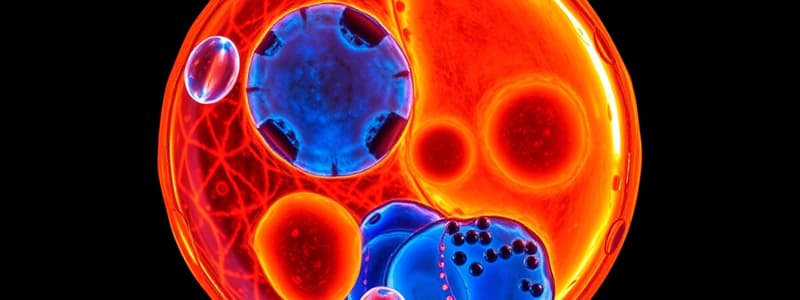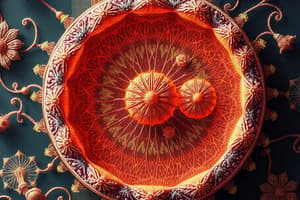Podcast
Questions and Answers
What is diffusion as it relates to cell function?
What is diffusion as it relates to cell function?
- Movement of substances from high to low concentration (correct)
- Movement of nutrients into the nucleus
- Movement of substances from low to high concentration
- Movement of water only
Osmosis refers specifically to the diffusion of water across the cell membrane.
Osmosis refers specifically to the diffusion of water across the cell membrane.
True (A)
What are the main stages of the cell cycle?
What are the main stages of the cell cycle?
Interphase, Mitosis, Cytokinesis
The structure that organizes spindle fibers during cell division is called __________.
The structure that organizes spindle fibers during cell division is called __________.
Match the following stages of the cell cycle with their descriptions:
Match the following stages of the cell cycle with their descriptions:
Which phase involves the chemical synthesis of DNA?
Which phase involves the chemical synthesis of DNA?
Only somatic cells undergo the cell cycle.
Only somatic cells undergo the cell cycle.
Which phase of interphase involves the replication of DNA?
Which phase of interphase involves the replication of DNA?
The mitotic phase consists of three distinct stages: Prophase, Metaphase, and Anaphase.
The mitotic phase consists of three distinct stages: Prophase, Metaphase, and Anaphase.
What are the main products of the G1 phase of interphase?
What are the main products of the G1 phase of interphase?
In the anaphase stage of mitosis, chromosomes separate at the ______.
In the anaphase stage of mitosis, chromosomes separate at the ______.
Match the phases of mitosis with their descriptions:
Match the phases of mitosis with their descriptions:
What happens during the G2 phase of interphase?
What happens during the G2 phase of interphase?
Sister chromatids are identical copies of the original DNA.
Sister chromatids are identical copies of the original DNA.
List the four phases of mitosis in order.
List the four phases of mitosis in order.
The phase of the cell cycle where the cell is performing its 'everyday job' is known as ______.
The phase of the cell cycle where the cell is performing its 'everyday job' is known as ______.
Which of the following correctly identifies the stages of the cell cycle?
Which of the following correctly identifies the stages of the cell cycle?
All cells undergo mitosis as a form of division.
All cells undergo mitosis as a form of division.
What is the primary purpose of cytokinesis?
What is the primary purpose of cytokinesis?
The process of producing offspring from one parent is known as ________ reproduction.
The process of producing offspring from one parent is known as ________ reproduction.
Match the type of reproduction with its description:
Match the type of reproduction with its description:
Why do cells need to divide?
Why do cells need to divide?
Cellular reproduction can occur through both mitosis and meiosis.
Cellular reproduction can occur through both mitosis and meiosis.
In which phase of the cell cycle does DNA replication occur?
In which phase of the cell cycle does DNA replication occur?
The sperm and egg cells are produced through the process of ________.
The sperm and egg cells are produced through the process of ________.
What differentiates asexual reproduction from sexual reproduction?
What differentiates asexual reproduction from sexual reproduction?
Flashcards
Diffusion
Diffusion
The process by which substances move from an area of high concentration to an area of low concentration.
Osmosis
Osmosis
Movement of a substance through a semi-permeable membrane from a region of high water concentration to a region of low water concentration.
Repair
Repair
The process by which cells divide to repair damage.
Mitosis
Mitosis
Signup and view all the flashcards
Chromatin
Chromatin
Signup and view all the flashcards
Interphase
Interphase
Signup and view all the flashcards
Cytokinesis
Cytokinesis
Signup and view all the flashcards
What is the cell cycle?
What is the cell cycle?
Signup and view all the flashcards
What is Interphase?
What is Interphase?
Signup and view all the flashcards
What is Mitosis?
What is Mitosis?
Signup and view all the flashcards
What is Cytokinesis?
What is Cytokinesis?
Signup and view all the flashcards
What is Asexual Reproduction?
What is Asexual Reproduction?
Signup and view all the flashcards
What is Sexual Reproduction?
What is Sexual Reproduction?
Signup and view all the flashcards
What is Meiosis?
What is Meiosis?
Signup and view all the flashcards
How do multicellular organisms grow?
How do multicellular organisms grow?
Signup and view all the flashcards
Why is cell division important for repair and renewal?
Why is cell division important for repair and renewal?
Signup and view all the flashcards
G1 Phase
G1 Phase
Signup and view all the flashcards
S Phase
S Phase
Signup and view all the flashcards
G2 Phase
G2 Phase
Signup and view all the flashcards
Mitotic Chromosome
Mitotic Chromosome
Signup and view all the flashcards
Prophase
Prophase
Signup and view all the flashcards
Metaphase
Metaphase
Signup and view all the flashcards
Anaphase
Anaphase
Signup and view all the flashcards
Study Notes
Cell Biology: Cell Division
- Biology is the only subject where multiplication is the same as division. This means that the process of making more cells is the same as splitting one cell.
The Cell Cycle
- The cell cycle involves cell growth and division.
- The cycle is divided into stages: Interphase, Mitosis (prophase, metaphase, anaphase, telophase) and Cytokinesis.
- Interphase is a preparatory stage before mitosis, further divided into G1, S, and G2 phases.
- G1 phase is the period of rapid cell growth, synthesizing new molecules.
- S phase involves DNA synthesis and replication.
- G2 phase prepares the cell for division, synthesizing more molecules.
- Mitosis is the process where the cell's nucleus and genetic material divide.
- Cytokinesis is the division of the cell's cytoplasm and the creation of a new cell.
Organelles
- Centrioles are organelles vital for cell division, particularly in animal cells. They form the spindle fibers which organize and guide chromosomes during mitosis
- Chromosomes: DNA is organized into chromosomes. It becomes a double helix, which is wrapped and coiled around histone proteins. Chromatin is the DNA-protein complex. During mitosis it condenses into a more compact structure called a chromosome.
Cell Division: Three Main Reasons
- Reproduction: Two types
- Asexual reproduction involves producing offspring with the same genetic makeup from one parent (e.g., bacteria).
- Sexual reproduction involved fusion of gametes (sex cells from two parents), resulting in genetically varied offspring. Gametes for fertilization usually come from separate parents; female - produces an egg, male - produces sperm. -Sexual reproduction involves meiosis to produce haploid sex cells (half the number of chromosomes).
- Growth: Multicellular organisms increase the number of their cells during growth; cell size is a limiting factor for efficient communication and movement within the cell.
- Repair: Damaged cells are replaced by new cells produced through cell division (mitosis) to repair the injury.
Mitosis Stages
- Prophase: Chromatin condenses into visible chromosomes. Centrioles move to opposite poles of the cell. Spindle fibers form. The nuclear membrane breaks down and nucleolus disappears.
- Metaphase: Spindle fibers attach to the centromeres of each chromosome. Chromosomes align along the middle of the cell (metaphase plate).
- Anaphase: Chromosomes separate at the centromere and are pulled to opposite poles by spindle fibers.
- Telophase: Chromosomes arrive at opposite poles of the cell, and daughter nuclei form. Chromosomes uncoil. The nuclear envelope reforms. Cytokinesis begins (division of the cytoplasm).
Cytokinesis
- Animals: Cytokinesis involves a constriction belt tightening around the equator to split the cell.
- Plants: A cell plate forms down the middle of the cell. The cell plate fuses with the existing cell wall.
- Stages of mitosis and cytokinesis vary among organisms though the underlying molecular processes are conserved.
Studying That Suits You
Use AI to generate personalized quizzes and flashcards to suit your learning preferences.



